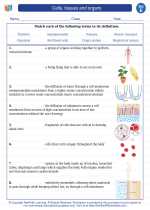Coal
Coal is a combustible black or brownish-black sedimentary rock formed from the remains of ancient vegetation which has been subjected to heat and pressure over millions of years. It is primarily used as a source of energy for generating electricity and heat.
Formation of Coal
Coal is formed from the remains of plants and trees that lived and died millions of years ago. When these plants died, their remains fell into swamps and wetlands, where they were slowly buried by layers of mud and debris. Over time, the pressure from the layers above and the heat from the Earth's core transformed these plant remains into coal.
Types of Coal
There are four main types of coal, which are categorized based on their carbon content and energy value:
- Anthracite: This is the highest quality coal, with a high carbon content and the highest energy density. It is often referred to as "hard coal" and is used for heating and generating electricity.
- Bituminous: This type of coal is softer than anthracite and has a lower carbon content. It is commonly used for generating electricity and making steel.
- Subbituminous: Subbituminous coal has a lower energy content than bituminous coal and is primarily used for generating electricity.
- Lignite: Also known as "brown coal," lignite has the lowest carbon content and energy value of all coal types. It is used mainly for electricity generation and heating.
Uses of Coal
Coal has been used for various purposes throughout history, and its primary uses today include:
- Electricity generation
- Heat generation for industrial processes and residential heating
- Steel production
- Chemical production
Environmental Impact
While coal has been a valuable source of energy, its use has significant environmental impacts, including air and water pollution, greenhouse gas emissions, and habitat destruction due to mining activities.
Study Guide
To study the topic of coal effectively, consider the following key points:
- Understand the formation process of coal and the factors that contribute to its formation.
- Learn about the different types of coal and their respective uses.
- Examine the historical and current uses of coal, including its role in energy production and industrial processes.
- Analyze the environmental impact of coal usage and the efforts to mitigate its negative effects.
- Explore the future of coal as an energy source and the potential alternatives for sustainable energy production.
[Coal] Related Worksheets and Study Guides:
.◂Science Worksheets and Study Guides Fifth Grade. Cells, tissues and organs

 Worksheet/Answer key
Worksheet/Answer key
 Worksheet/Answer key
Worksheet/Answer key
 Worksheet/Answer key
Worksheet/Answer key
 Vocabulary/Answer key
Vocabulary/Answer key
 Vocabulary/Answer key
Vocabulary/Answer key
 Vocabulary/Answer key
Vocabulary/Answer key
 Vocabulary/Answer key
Vocabulary/Answer key
 Vocabulary/Answer key
Vocabulary/Answer key
 Vocabulary/Answer key
Vocabulary/Answer key
